Like Riding In A Tesla
Meeting with Tom Tucker, House Committee on Appropriations
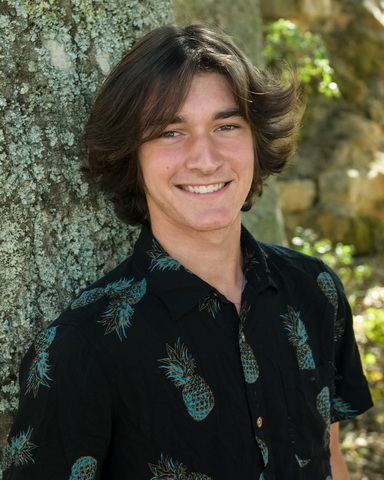
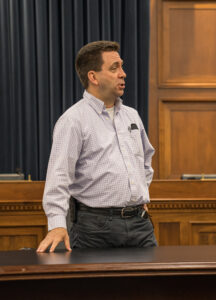
Today we met with Tom Tucker, a Director of Operations at the House of Representatives, in the House Appropriations Committee room. Tom helped arrange our interview with Farar Elliott, and he has helped arrange past Mount Madonna trips to DC. He gave us lots of information about working for the House of Representatives from an insider’s point of view, and how important the people behind the scene are to the process. He talked about how working in that branch of government is “like riding in a Tesla”: once your party becomes the majority, your head is “thrown to the back of the seat” when the pace of work accelerates quickly. It was fun to hear about how the government works “behind the scenes” rather than learning about government from our textbooks.
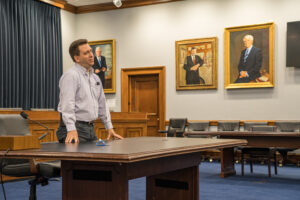
He also gave his backstory about how he began working in government, which I thought was very interesting, as his career path is not one that most people take. He started as a concierge at the Four Seasons Hotel, but when that became routine, he applied for jobs on Capitol Hill. Although he had no luck at first, he eventually found an internship with former representative Sam Farr. After four months of long days and sleepless nights—working as an intern during the day and as a concierge at night—he “stumbled into” a full-time job with Sam Farr, which he has held for the last twenty years before his job in House Appropriations. I found his story extremely interesting, because although his work is often difficult and stressful it is also fun, which is why he has stayed at it for so long. Tom is a kind and informative person, and I appreciated his giving us time to talk to him and setting up yet another great interview for the yearly DC trip.
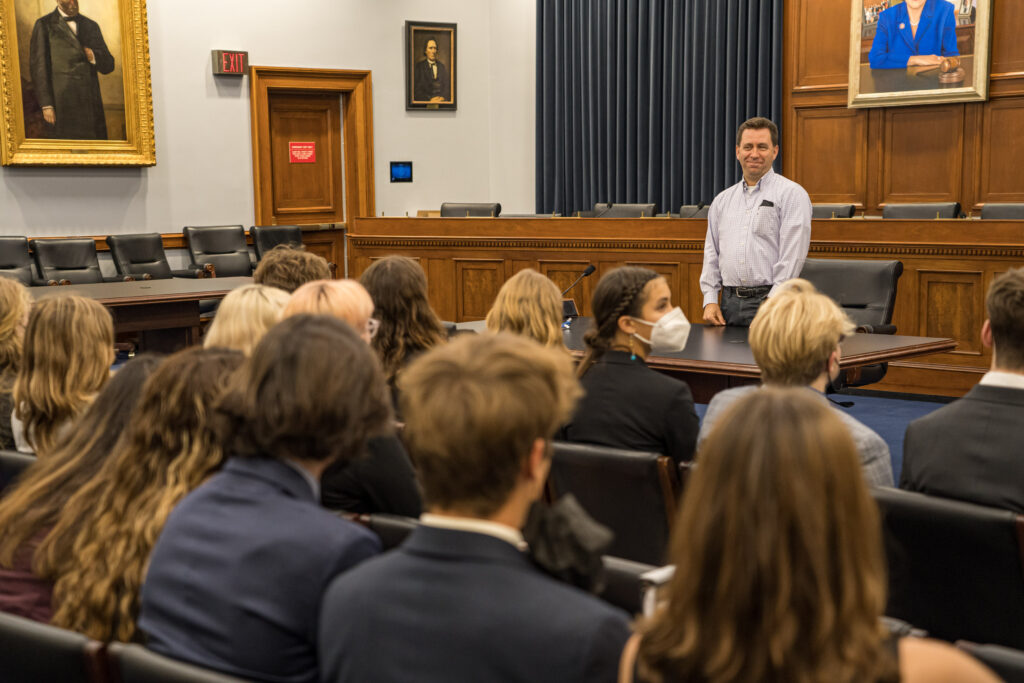
“America’s Greatest Contribution to the World Has Been Its Values”
Interview with Senator Ben Cardin
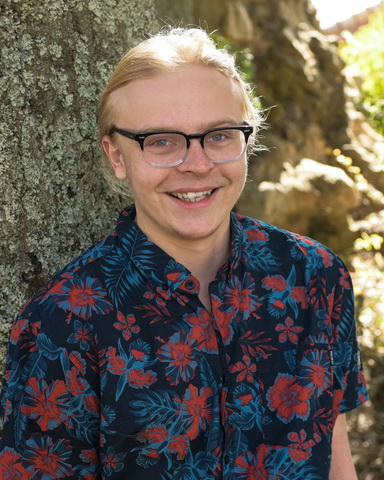
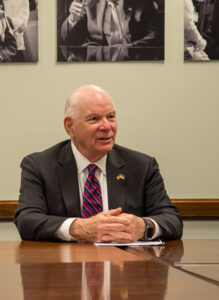
Today we interviewed Maryland Senator Ben Cardin. While we only had a short, thirty-minute interview with him, he nevertheless had time to say some really interesting things. He spoke about immigration law, noting that in the US two of our foundational values are freedom and opportunity. America is, after all, the Land of Opportunity. However, we cannot claim this title if we cannot provide equal freedom and opportunity to those who come to this country to become Americans. Current immigration laws do not reflect American ideals: “America, in its actions, is not living up to its values.” Currently, we reject too many people who seek a better life and better opportunities, and we reject people who seek political asylum, including people who have fled their country to escape persecution and human rights violations.
I also appreciated Cardin’s view that political campaigns should be more transparent. He told us that he takes the time to go to rural areas of Maryland, talk to the people there, and work on their behalf, even though he knows that it is quite difficult to change people’s minds and that he most likely will not be getting their votes. Even though he doesn’t need those votes to get elected—as he receives enough votes from cities like Baltimore—he still makes an effort to work on behalf of all the people in his state.
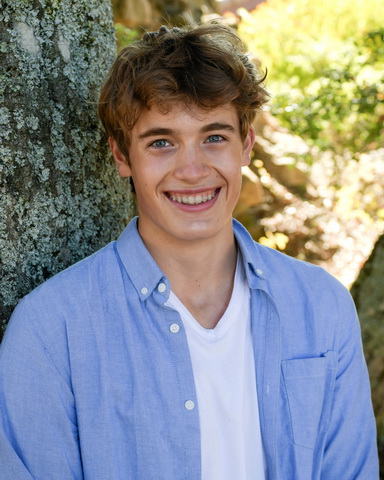
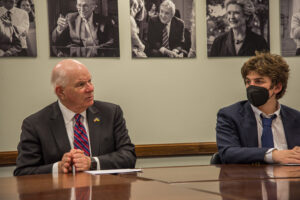
Today we toured the Capitol and interviewed Sen. Ben Cardin (Maryland). The interview with Senator Cardin was for me the most interesting interview we have had on this trip. It seemed that everyone was looking forward to it. The tour of the Capitol prior to the interview was packed with information, such as the history of various statues and the story of the three artists who painted the dome of the Capitol. We all eagerly anticipated the interview as we ate lunch in the Senate cafeteria, one of the best meals of the trip so far. After Sen. Cardin entered the room, we all stood to greet him, and he made a funny remark that released some of the tension we all shared. We had originally planned for an hour with him, but we were informed that he could only stay for twenty-five minutes, forcing us to streamline our interview to six key questions, all of which provoked thoughtful answers on his part.
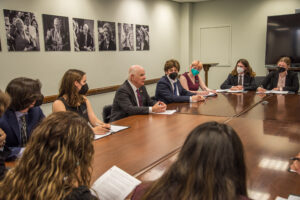
Throughout all of the interviews this week there has been a common theme of listening to the other side and coming to a compromise. Cardin too focused on the importance of this theme in several of his answers. We then asked questions about voter suppression, and Cardin responded with the claim that voter suppression negatively affects everyone. He also commented on the fact that we need to change the way we finance elections to make our democracy less partisan. He passionately argued that there needs to be more financial transparency in political campaigns, which seems to me to be necessary if we are to maintain and strengthen our democracy.
He made an important point about the need to be more loyal to our country than we are to our political parties, and he noted that, historically, “when we have a threat, we put the country first.” He then placed his hand on the desk and said in a very solemn tone, “we should do that more often.” This for me was a “wow” moment: I could see his genuine passion for what he does, and I could tell that his own sense of morality pushes him to be his best self in politics.
As the trip is wrapping up, I find myself looking back to our first day here and contrasting it with where we are now. I’ve had many profound experiences and been exposed to views I had not encountered before, making me think deeply about many aspects of my own life. This trip has deepened my understanding of how the US government works, which I know will be most important in the future.
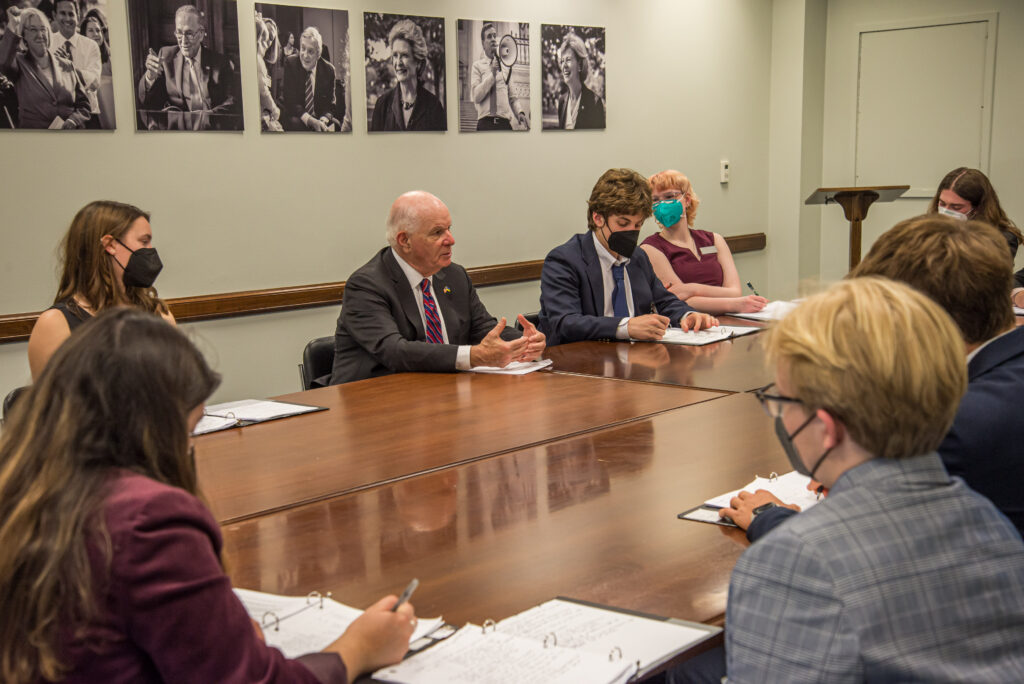
Geolocation Dave
Meeting with David Schmerler at the James Martin Center for Nonproliferation Studies
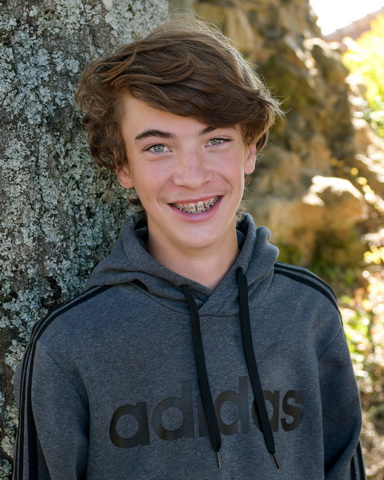
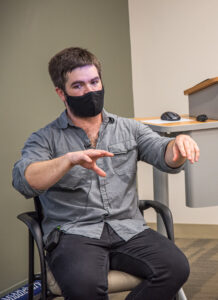
Today we traveled to the James Martin Center for Nonproliferation Studies (CNS) and interviewed Dave Schmerler, a Senior Research Associate. CNS is a non-government organization dedicated to the prevention of nuclear proliferation and war, and Dave deals specifically with North Korean intelligence. As a geolocationist, he looks closely at North Korean media and tries to gather information such as the location of nuclear testing sites and the level of advancement of their nuclear technology.
He began our talk with a short slide show and then took our prepared questions. One answer that was surprising to me was when he told us that CNS’s technology is miles behind whatever the federal government uses, and that his job is more about educating the public and providing meaningful analysis. He told us that any threats requiring immediate action are seen first by the government, and that CNS does not play a role in gathering intelligence or in any response to what the government finds. He showcased the software that he uses to detect photoshopping in official photos by countries like North Korea and Iran. The software just detects heat, so if a photo shows a rocket propulsion flame without heat waves, he knows that the photo is probably fake, and that the rocket probably did not launch.
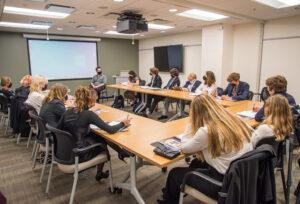
The interview was very unique, because Dave is closer to our age than are the other interviewees so far, and we were therefore able to talk to him more informally. Our interview felt like a conversation, and at the end of our planned questions we were able to come up with at least fifteen more questions off the top of our heads—something that had not happened in the other interviews.
The most interesting thing he talked about was his process of determining where a North Korean testing site is located based on nothing more than a picture of a Korean building with some missile smoke in it. With an entire country to search, it’s amazing that he is able to do this. We learned—much to his embarrassment—that an old nickname of his is “Geolocation Jesus.”
At the end of the interview, he let us use his VR headset to look at a 3D model he created of a North Korean nuclear weapons lab. This interview was my favorite so far because of how he piqued our interest and allowed us to interact so informally with him. This informality encouraged us to ask the questions we were genuinely interested in asking. He is clearly very smart, and I was impressed both with his ability and the way he answered our questions.
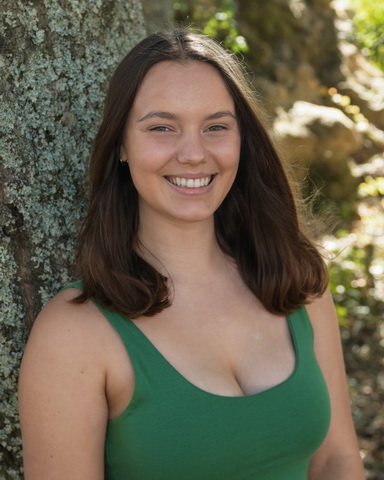
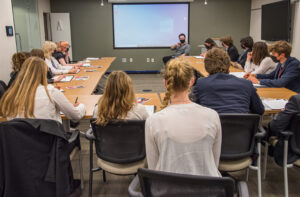
Today was an incredible experience for me. Our interview with Dave Schmerler not only fascinated me, but it was so stimulating that I asked more questions in this one interview than I’ve asked over the course of this trip so far. Schmerler is young yet incredibly well-educated in his field, and there was so much to talk about that I could have asked him questions for hours on end.
Dave Schmerler specializes in terrorism studies, and his primary tool for investigation is open-source geolocation technology. He uses resources such as satellite images, image tracing, and even social media to determine what is in photos and when they were taken. He uses the information from these photos to monitor nuclear weapon sites in North Korea and Iran.
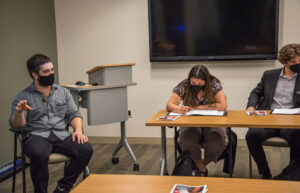
Dave explained geolocation to us, and I was genuinely amazed at how he utilizes it. He uses pictures from weapon launching sites to determine where those launching sites are, even though almost all of the official photos of those sites are blurred in order to keep the locations secret. He uncovers state secrets using the information from photos! Talking to him and hearing about how he narrows down the location of one photo from almost nothing—often only knowing what country it was taken in—was mind-blowing (get it?).
This interview was unique because of how young Schmerler is. It’s inspirational to see someone who is not only passionate about what he’s doing but incorporating what he loves into his job. Dave has a fascination with video games and virtual reality, and he uses those resources to further his work. He uses 3D virtual models to make displays of the bases he’s found in North Korea, and he has even used Minecraft to make his work more accessible to the general public. It was very satisfying to ask such an intellectual any question that popped into my head. I am grateful for the opportunity to talk to him, and I hope that younger Mount Madonna students can interview him and enjoy the same unforgettable experience that I had today.
Failure is an Option
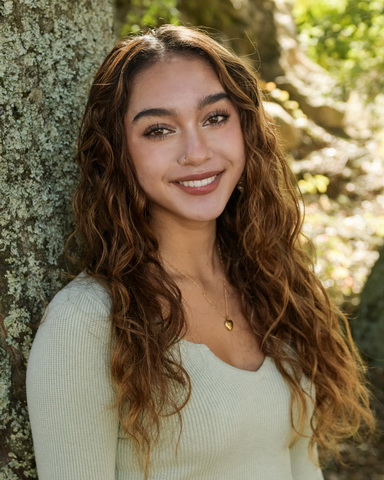
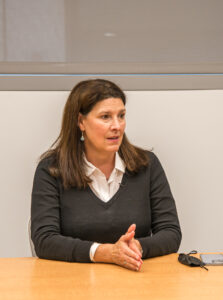
I have been looking forward to the Susannah Wellford interview all week. Susannah Wellford is a lawyer who founded the organization Running Start. Running Start’s goal is to get more women into politics regardless of their political views. Cecily and I worked together on this interview for the past two days on all aspects of the process, writing, reassuring, editing, and ordering of questions. We were both really proud of the result that we put together. Susannah Wellford had a series of articles talking about everything from gender to fighting sexism in the workplace, all of which subjects I really care about and was looking forward to hearing about more.
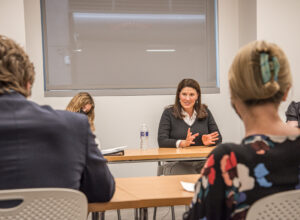
One of the major takeaways from this interview was how to support women and fight against sexism. One thing that she recommended to us was to not be compliant. She admitted that as difficult as it is, it’s incredibly important that we call out sexist behaviors when we see them. It’s okay to make people uncomfortable, and it might lead to unforeseen consequences for women, but calling out this behavior makes it less normalized. Overall, her advice to women was to support and bolster one another.
A moment that really made me emotional was when she gave her advice to men and white individuals regarding how to support women and all people of color. Her advice for amplifying our voices is to validate the things we have to say, acknowledge what we have to say, and make it known. This advice resonated with me because as a woman of color there are times when I feel ignored. I am very vocal about the things I believe in, and I always try to fight back when something infringes on my values. However, I don’t always think that what I have to say is worthwhile. Validation from my peers keeps me going, making me feel that my fight for justice is worth continuing.
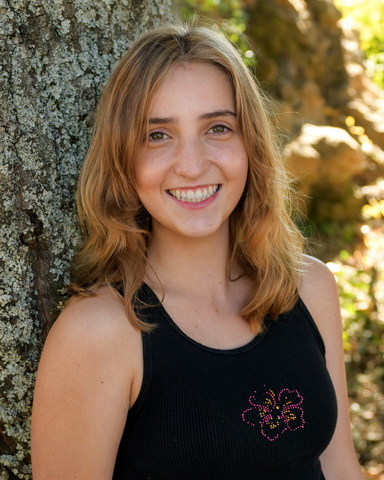
“We cannot take any of our rights for granted.”
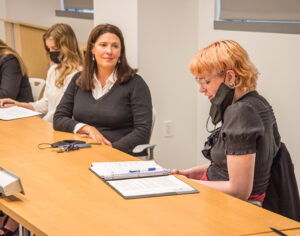
This is what Susannah Wellford said when asked about how we as young people can maintain our passion for politics even when everything seems to be going wrong. Going into our third day of interviews in Washington DC, I was especially excited to interview Susannah Wellford, the founder of Running Start, an organization dedicated to providing women with the confidence and experience to run for office. Both of my sisters had previously interviewed her, and they both expressed to me how much they had enjoyed talking to her.
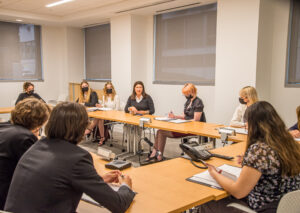
Going in with such high expectations, I was a little nervous, but as the interview progressed those worries melted away. Talking to Susannah was one of the most insightful conversations I have had, as she answered every question we had with ease and eloquence. At one point in the interview, we began talking about the overturning of Roe v. Wade. Susannah said, “Be angry about changes that could affect your freedom” and went on to talk about how we must not become complacent about protecting women’s rights. This thought really struck me, because recently people have become too comfortable with the idea that everything is going to be okay, and her words reminded me that there is still work to be done.
Throughout the interview, Susannah shared a plethora of knowledge and information on how women and men can work together to create a more accepting work environment. She also talked about the work that she does with young women to change the way the political environment is structured, which excited me about the future of politics. At another point, when asked about failure, Susannah talked about how failure is necessary and something that should be normalized. As a young woman who often feels pressure to be perfect, hearing such an incredibly accomplished woman talk openly about her own failures and even advocating for the benefits of failing—was encouraging and comforting. It is necessary to remind young women everywhere that they are good enough, and that failure is inevitable and necessary.
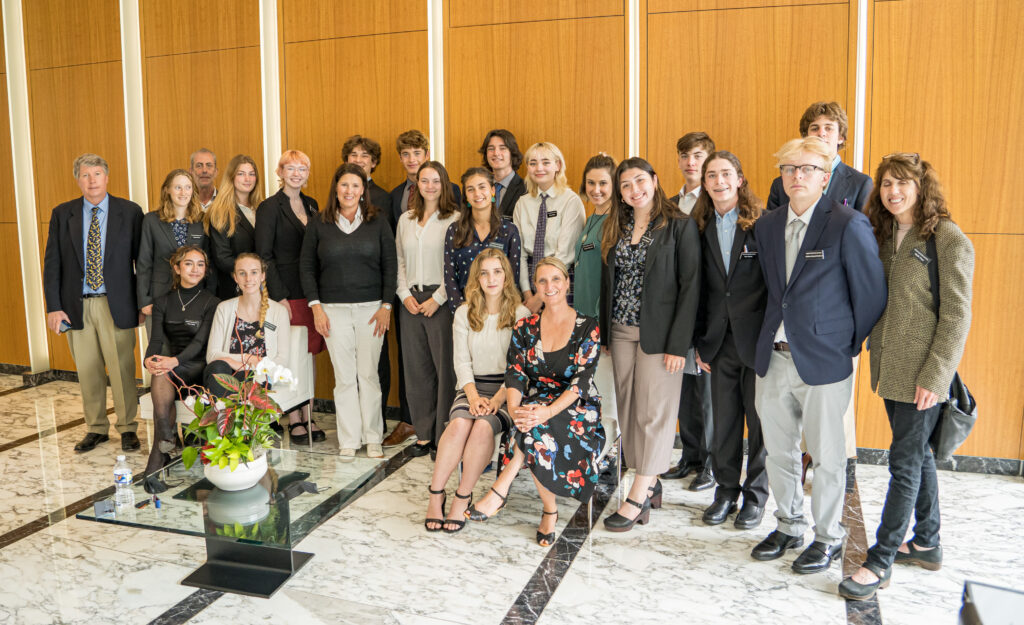
Everyone Deserves the Opportunity to Share Their Story
Interview with Alexandra Toma, Executive Director of the Peace and Security Funders Group
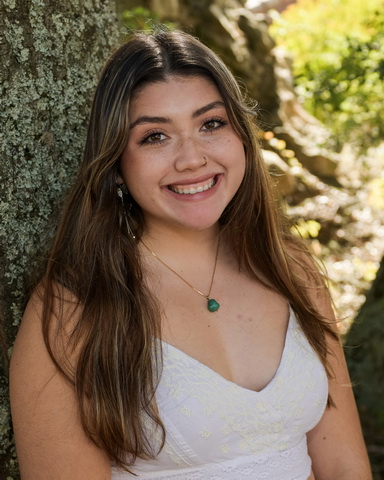
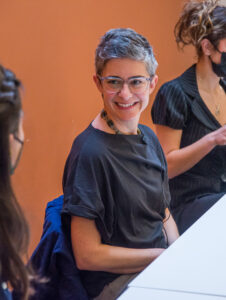
This morning, we had the opportunity to interview Alexandra Toma from the comfort of our hostel, which I very much enjoyed. Toma is a philanthropist, the executive director at the Peace and Security Funders Group based in Washington, DC. She is also a refugee who uses her platform to give voice to and help other refugees.
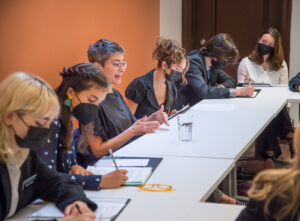
Two important values in my life are self expression and equality. I believe that everyone deserves the opportunity to share their story—who they are and what they stand for—without fear of not fitting in, being judged, or being harmed in some way. I found Toma’s words reassuring when she spoke about her values and how she strives to implement them in her work and life. She mentioned that if one has the power and privilege to use their voice, one should use it in a way that challenges assumptions and that makes people think differently. It was evident that Toma believes in standing one’s ground when faced with adversity, having the courage to speak up for one’s values, and treating everyone equally without judgment or assumptions. These are messages that more people, regardless of age, need to hear.
She stated that the key to mobilizing others to create positive change in their communities is to share their stories. When we are able to connect with each other on a personal, human level, by listening to each other’s stories, different perspectives are acknowledged, and positive change becomes possible.
I am grateful for the time we spent with Toma, as well as for her willingness to stand up for what she believes in to better the world for others who do not have the same opportunities. I find her mission of selfless service truly admirable and inspiring.
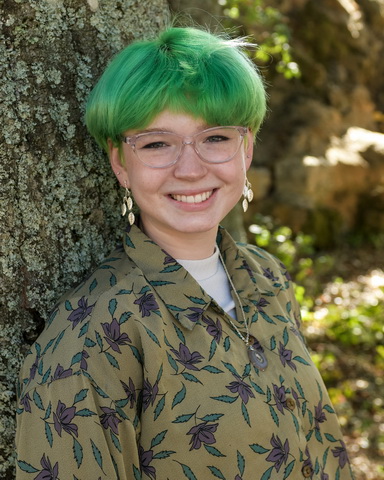
Until today, we have been rushing to make it to our interviews and activities on time. This morning, however, we had the luxury of conducting the first interview of the day in the space we use as a work room in our hostel. As a result, I felt less nervous for this interview than I did for the others, as we were in familiar territory. We met with Alexandra Toma, executive director of the Peace and Security Funders Group (PSFG), which is “a network of foundations and individual philanthropists investing in peace and global security,” according to the website.
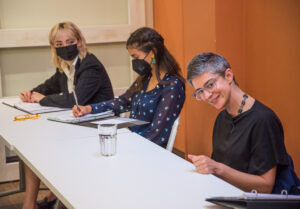
I had heard of NGOs before. In Model UN we use them as an easy source of funding, but prior to doing research for this interview and speaking with Toma, I knew nothing more than about them. I was thus interested to learn more about such organizations, which operate behind the scenes and don’t necessarily receive all the press or credit they deserve. Toma described how PSFG responded to the humanitarian crisis in the Central African Republic, “go[ing] in kind of like the tip of a spear,” and thus “able to use a little bit of our money and leverage and a lot of money from the United States government.” Her description reminded me of how some people talk about trading stock: you might start with a little, but a little can eventually go a long way.
One theme that arose multiple times throughout the interview was that of public speaking skills. Although she said that such skills are not necessary for everyone, they have been helpful in her career. In particular, she said, her high school speech and debate courses taught her how to “stop and think about how to answer [questions] in a way that’s valuable to my audience.”
Another thing that struck me was simply how much she has accomplished. When asked what advice or reflections she has, based on her college experience, she replied that “you don’t know what you don’t know,” so “just try everything once in your life.” She has worked as a paralegal, an embassy intern in Stockholm, a shadow to a surgeon, and several other occupations—all because she pursued opportunities and possibilities. It was inspiring to see someone who is unafraid to try new things and able to follow through on her interests. It is both terrifying and liberating to realize that my plans for the future are not entirely concrete, and it’s possible—even probable—that my plans will change.
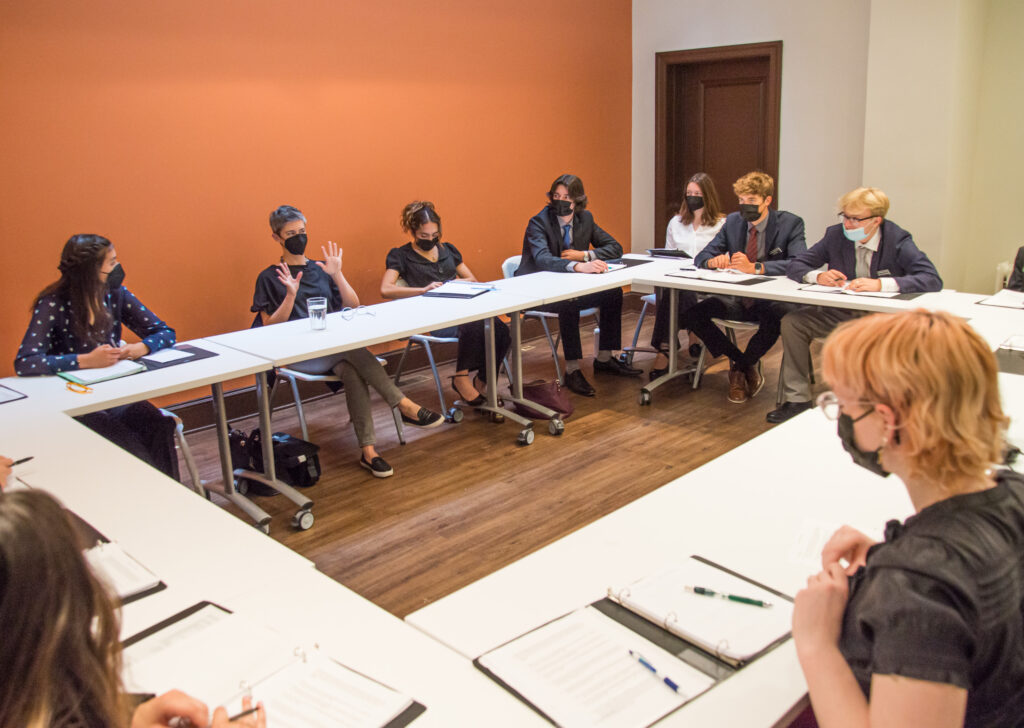
Like Pop Rocks in Your Brain
Interview with Farar Elliot, Chief of the Office of Art and Archives, House of Reps.
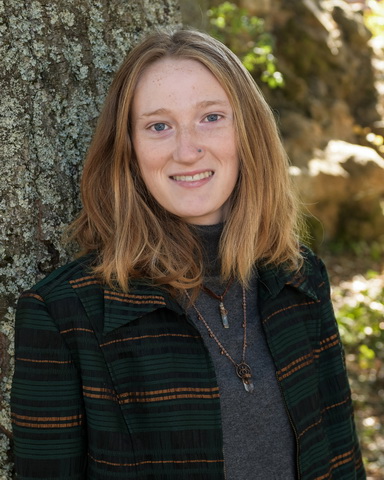
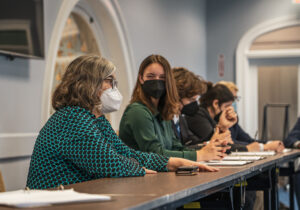
This morning we interviewed Farar Elliott, the Chief Office of Art and Archives at the House of Representatives, whom l was very excited to interview. In the last week or so, I have been researching her and what she does. I found out that a curator can do everything from finding pieces to display to figuring out and writing the narrative that the objects tell to figuring out where and how to organize the exhibits. After finding out what curating really entails I looked up colleges that had programs on different types of curating or related majors, even though I already know where I am going and what my major will be. I found out that curating is combining story telling, history, art, and sometimes even science. Needless to say, I was very intrigued to interview her.
When we arrived at the Library of Congress to interview Elliott, we could hear protesters in front of the Supreme Court who were there to protest the possible overturning of Roe v. Wade. We then found out that the interview would be a little later than expected, so we wandered over to the group of people who were protesting. I was surprised to discover that the majority of people there were anti-abortion. We soon found a small group chanting, “My body, my choice!” and joined them. I have never been to a protest at which the opposing side was also present. It was very emotional to see people so passionately chanting on both sides. It was definitely a new experience for me to see and hear firsthand a group of people that believe so firmly in an opposing view.
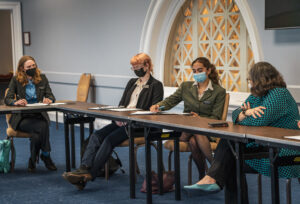
After attending the protest, we talked about what a protest really does and how it is a good way to show support, but we also talked about how there are other ways to be helpful and make a change that are more productive. We then walked over to meet Elliott. When she first showed up she was very personable, and immediately I became even more excited to talk with her. I wrote a few questions for this interview, but I ended up asking her what was the most challenging part of creating an exhibit, and what was her favorite part. In response to the first question, she stated that it is difficult to figure out which narrative to present and what to say about each object so that viewers are given the most important information without over-explaining, and the object “speaks for itself.”
In response to the second question, she said that she is always looking for and excited by creative “click” or Aha! moments that sometimes occur when you find the missing piece to a puzzle you have been trying to solve. Her response resonated with me. When I am making art or doing some creative project, it is the best feeling to experience that “click,” when everything seems to align and come into focus. I worried that since I am going into a design program at college I might burn out and lose that creative inspiration that I love so much—that being creative and artistic might become a “mere” job and a chore. However, hearing her talk about her continuing love for working in a creative field—that she still experiences those Aha! moments that feel like “pop rocks in your brain”—gives me hope that I will continue to love art and design even if it becomes a job.
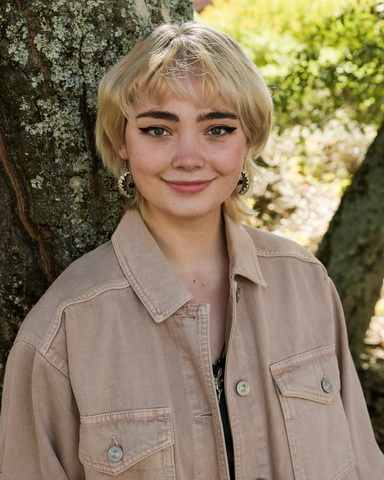
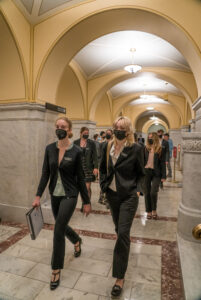
After a chaotic morning outside of the Supreme Court building, we met Farar Elliott at the Library of Congress, an absolutely gorgeous building. This is the interview I’ve most looked forward to because she has such an interesting job: Curator and Chief of the Office of Art and Archives for the House of Representatives. As soon as she greeted us the tone was conversational, and it was clear that she would be fun to talk to.
She talked about her work curating and the goal of having objects drive the exhibition. It was really interesting to hear about her process of collecting objects that tell stories, and how objects with human activity/damage are more valuable.
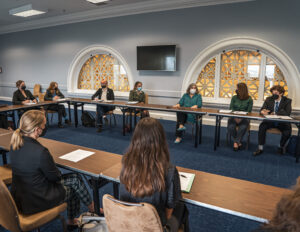
Zoey and I spent quite some time last night crafting a question for Farar Elliot, and the answer she gave us was very interesting. We asked about her thoughts on contextualizing, rather than removing, controversial monuments and art of historical figures.
She answered that we should contextualize old monuments and add additional monuments that reflect our current beliefs. However, she also recognizes that there are times when it’s good to take monuments down. She mentioned the statue of Robert E. Lee in Richmond, Virginia, onto which BLM protestors projected art prior to its removal, and how satisfying it was to witness the process of its eventual removal.
She had a refreshing take on the permanence of history and the potential for change. She said that when things break you often see they are useless, so that they no longer serve their purpose. The idea that we can let go and move past parts of history/government is something I’ve never heard discussed in this way before, and it left me hopeful about all the changes that could eventually occur.
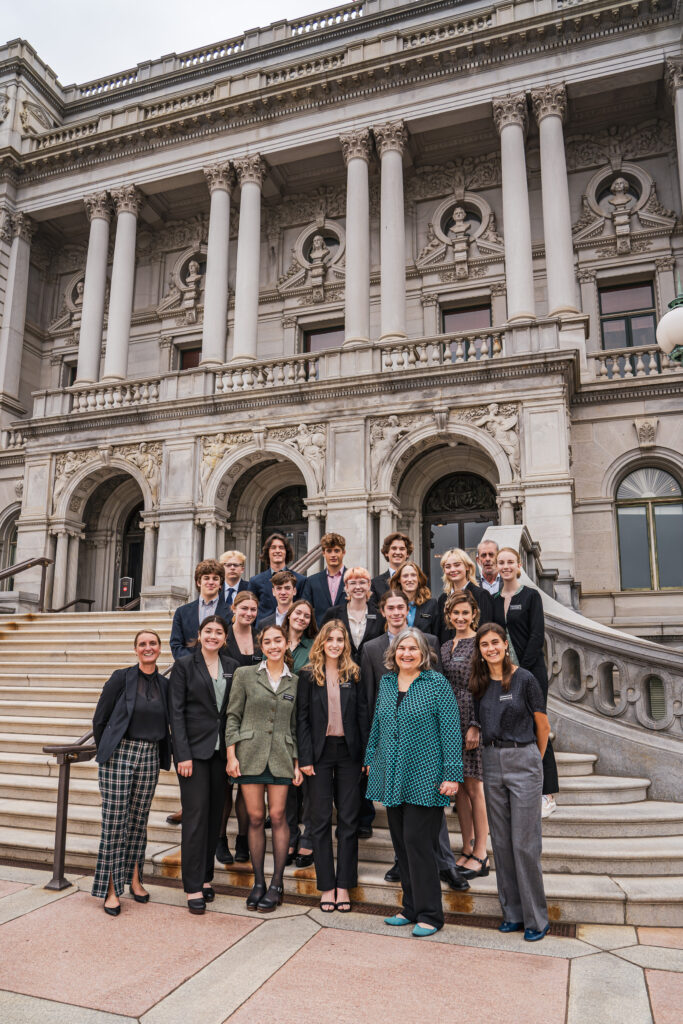
Democracy is a Responsibility
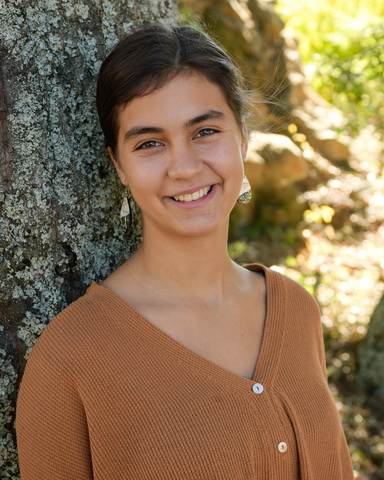
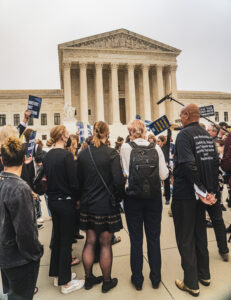
This morning, from the steps of the Library of Congress, we could hear chanting and shouts coming from outside the Supreme Court. We were about to meet the Chief of the Office of Art and Archives of the House of Representatives, Farar Elliott. We were excited to meet her and speak to her about her intriguing job. At the same time, the recent leaking of the draft opinion from the Supreme Court regarding the possible overturning of Roe v. Wade was on our minds. We were intrigued by the protest and wanted to be a part of this important event.
As it happened, our interview with Ms. Elliott was moved to a couple of hours later, so our entire group crossed the street to observe the action. I was excited but a little unsure of what to expect, given that the topic of abortion has been long debated, contested, and is a key issue in the fight for women’s rights.
When we arrived at the stairs of the Supreme Court building, we found a gathering of both supporters and opponents of Roe v. Wade. However, the opponents outnumbered the supporters, which I found alarming. Nevertheless, as our chaperone Chelsea told us afterward when talking about our experience, it is important to hold space for all sides to have their beliefs and to think critically about what it is we believe and will fight for. It was fascinating to see how certain groups that are stereotypically liberal or progressive were waving banners supporting the ban on abortion, while certain groups that are typically seen as more conservative were shouting chants to protect women’s choice. Everywhere I turned it was hard to discern who was arguing what, and people who looked like me did not necessarily hold the same beliefs at that moment as other people who had vastly different backgrounds from mine.
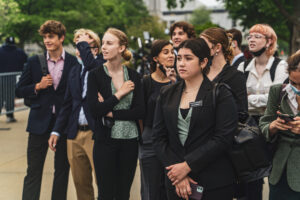
I joined in with the girls in our group, and eventually I felt the courage to chant and participate. I felt the support of women and others I had never met, and they let us know that they were inspired by our group. I felt gratitude towards the boys in our group who joined us in the protest because I believe that feminism is not just for women. Even though I am passionate about activism and protecting human rights around the world, my introversion initially held me back from letting my voice be heard. After giving myself the space to watch and observe, I joined the protest. I gave thought to the arguments at that moment—as I had done many times before today—so I did not feel that I was blindly rushing into conflict. I chose to follow what I felt was right, to call attention to the serious damage that a ban on abortion would have. Overturning Roe v. Wade could have serious implications not only for women but for anyone who can become pregnant or has to handle an unwanted pregnancy. According to the Center for Disease Control, these implications disproportionately affect people of color and those with fewer economic/ healthcare resources, as Black and Indigenous women are up to three times more likely to die from pregnancy-related issues than white women.
With some guidance from our chaperones, we reflected on the high emotions of the moment. An important thing we talked about is that protesting is just one step in making the changes we want to see. Protesting is absolutely essential, and it does well to rally people for a cause, and it has been pivotal in plenty of social, political, and environmental movements. However, protesting needs to be backed up by community organization, changing or creating legislation, and investing resources in active solutions. I am glad to have been a part of this protest because this SCOTUS decision will directly impact my and future generations, and I feel fortunate that I had the space to think critically about the experience.

Waking up this morning on the second day of our interviews in Washington, DC, we were met with a dull, gray, overcast morning, the weather reflecting the dismal mood that women across the country were feeling after the upsetting events of the previous night. The preemptive leak of the monumental decision to overturn Roe vs Wade left women around the country feeling betrayed, heartbroken, and angry.
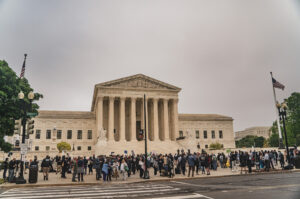
Some of us thought little of this decision at first. It was just another morning in DC, as we rushed to get out the door, clad in fancy clothes, ready to interview important people. As we made the trek to our first interview at the Library of Congress, we began hearing the faint noises of protesting at the Supreme Court of the United States, located next to the Jefferson Building. When we arrived at the Library, it was apparent that there had been a little mix-up, and Farar Elliott, the curator of the House of Representatives, would not be arriving for at least another hour.
On any other day, this would have been disappointing: the thought of having to sit around in cold weather for another hour would have upset most of us, but today was different. We immediately knew that we wanted to go get involved, to protest in support of our beliefs, and exhibit our First Amendment rights. When I walked over to the protest, I was stunned. I was expecting to see and hear women protesting this abhorrent ruling, screaming chants for their right to choose. Instead, I was met with the opposite: women cheering at the overturning of Roe vs. Wade. I was disgusted. How could these women be excited to lose their rights? How could they be protesting their own right to choose?
After a few moments of taking in this sight, I regrouped with my peers and watched from afar as people cheered over the robbery of my choice. Eventually, a woman from the other side of the protest made her way to us and we followed to join her. We began chanting, “Keep your hands off my body” and “Hey Hey, Ho Ho, your backwards views have got to go.” We chanted in the face of oppression as “progressive Catholics” screamed back at us. This lasted for a while, as we protested for our rights and pro-life protestors inched towards us, forcing us to move backward.
We used our voices to express our beliefs and fight for those who will be more affected by this ruling than we might. When it was time to head to our interview, we were fired up and apprehensive about leaving. We turned away from the crowd, and walked away on the promise that we would be back.

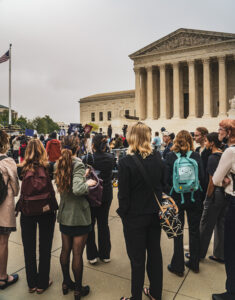
I was sitting in the hostel bedroom with all of my friends when I found out about the leaked SCOTUS decision. We were all immediately outraged. Being a group of teenage girls, we felt this on a personal level, this decision being something that has the potential to affect us all individually.
The next day we went to the Supreme Court to protest, one of the most surreal experiences I have ever had. I have been involved in protests in the past, as I planned a Black Lives Matter Protest in June 2020. However, the difference between protesting in Santa Cruz and DC was stark. In Santa Cruz, everyone around you is on the same side, but there in front of the Supreme Court building, it was a mix of opinions. Everyone is passionate, but not everyone agrees with you. It’s hard not to become aggravated by other opinions, but it was important for us to focus on supporting one another and the others around us.
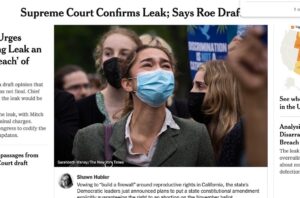
The scene was really emotional. I saw my best friend crying, and I broke down myself. The precedent that the overturning of Roe v. Wade sets has the potential to take away more than just our rights to abortion, but could also result in bans on birth control and gay marriage. It feels like we are moving backward. These are my rights, this is my body. While protesting, I felt pure desperation.
On a more positive note, I could feel so much support around me. Many women in the crowd made sure that I and my friends were safe. They were motherly, and they demonstrated the community that fighting for a common cause creates. Being able to look behind me to see my male friends passionately yelling for my right to choose was also touching. Knowing that people care even when an issue doesn’t directly affect their lives added to the feeling of community.
It felt like I was a part of history today. We were nervous when participating in a DC protest, especially in such a momentous location like today. We only realized the magnitude of what we had experienced until later in the day, when we checked the New York Times and saw our picture on the cover. We then realized just how much impact we as individuals can have. I’m proud to say that I am fighting for this cause.
You must be logged in to post a comment.